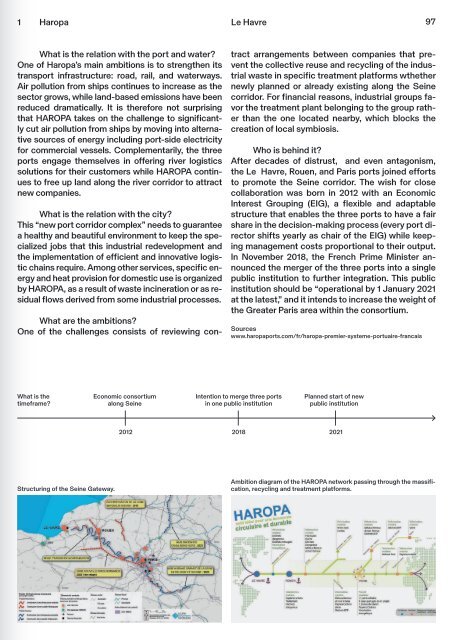Circular City Ports - Workbook
You also want an ePaper? Increase the reach of your titles
YUMPU automatically turns print PDFs into web optimized ePapers that Google loves.
1 Haropa Le Havre<br />
97<br />
What is the relation with the port and water?<br />
One of Haropa’s main ambitions is to strengthen its<br />
transport infrastructure: road, rail, and waterways.<br />
Air pollution from ships continues to increase as the<br />
sector grows, while land-based emissions have been<br />
reduced dramatically. It is therefore not surprising<br />
that HAROPA takes on the challenge to significantly<br />
cut air pollution from ships by moving into alternative<br />
sources of energy including port-side electricity<br />
for commercial vessels. Complementarily, the three<br />
ports engage themselves in offering river logistics<br />
solutions for their customers while HAROPA continues<br />
to free up land along the river corridor to attract<br />
new companies.<br />
What is the relation with the city?<br />
This “new port corridor complex” needs to guarantee<br />
a healthy and beautiful environment to keep the specialized<br />
jobs that this industrial redevelopment and<br />
the implementation of efficient and innovative logistic<br />
chains require. Among other services, specific energy<br />
and heat provision for domestic use is organized<br />
by HAROPA, as a result of waste incineration or as residual<br />
flows derived from some industrial processes.<br />
What are the ambitions?<br />
One of the challenges consists of reviewing con-<br />
tract arrangements between companies that prevent<br />
the collective reuse and recycling of the industrial<br />
waste in specific treatment platforms wthether<br />
newly planned or already existing along the Seine<br />
corridor. For financial reasons, industrial groups favor<br />
the treatment plant belonging to the group rather<br />
than the one located nearby, which blocks the<br />
creation of local symbiosis.<br />
Who is behind it?<br />
After decades of distrust, and even antagonism,<br />
the Le Havre, Rouen, and Paris ports joined efforts<br />
to promote the Seine corridor. The wish for close<br />
collaboration was born in 2012 with an Economic<br />
Interest Grouping (EIG), a flexible and adaptable<br />
structure that enables the three ports to have a fair<br />
share in the decision-making process (every port director<br />
shifts yearly as chair of the EIG) while keeping<br />
management costs proportional to their output.<br />
In November 2018, the French Prime Minister announced<br />
the merger of the three ports into a single<br />
public institution to further integration. This public<br />
institution should be “operational by 1 January 2021<br />
at the latest,” and it intends to increase the weight of<br />
the Greater Paris area within the consortium.<br />
Sources<br />
www.haropaports.com/fr/haropa-premier-systeme-portuaire-francais<br />
What is the<br />
timeframe?<br />
Economic consortium<br />
along Seine<br />
Intention to merge three ports<br />
in one public institution<br />
Planned start of new<br />
public institution<br />
2012 2018 2021<br />
Structuring of the Seine Gateway.<br />
Ambition diagram of the HAROPA network passing through the massification,<br />
recycling and treatment platforms.


















